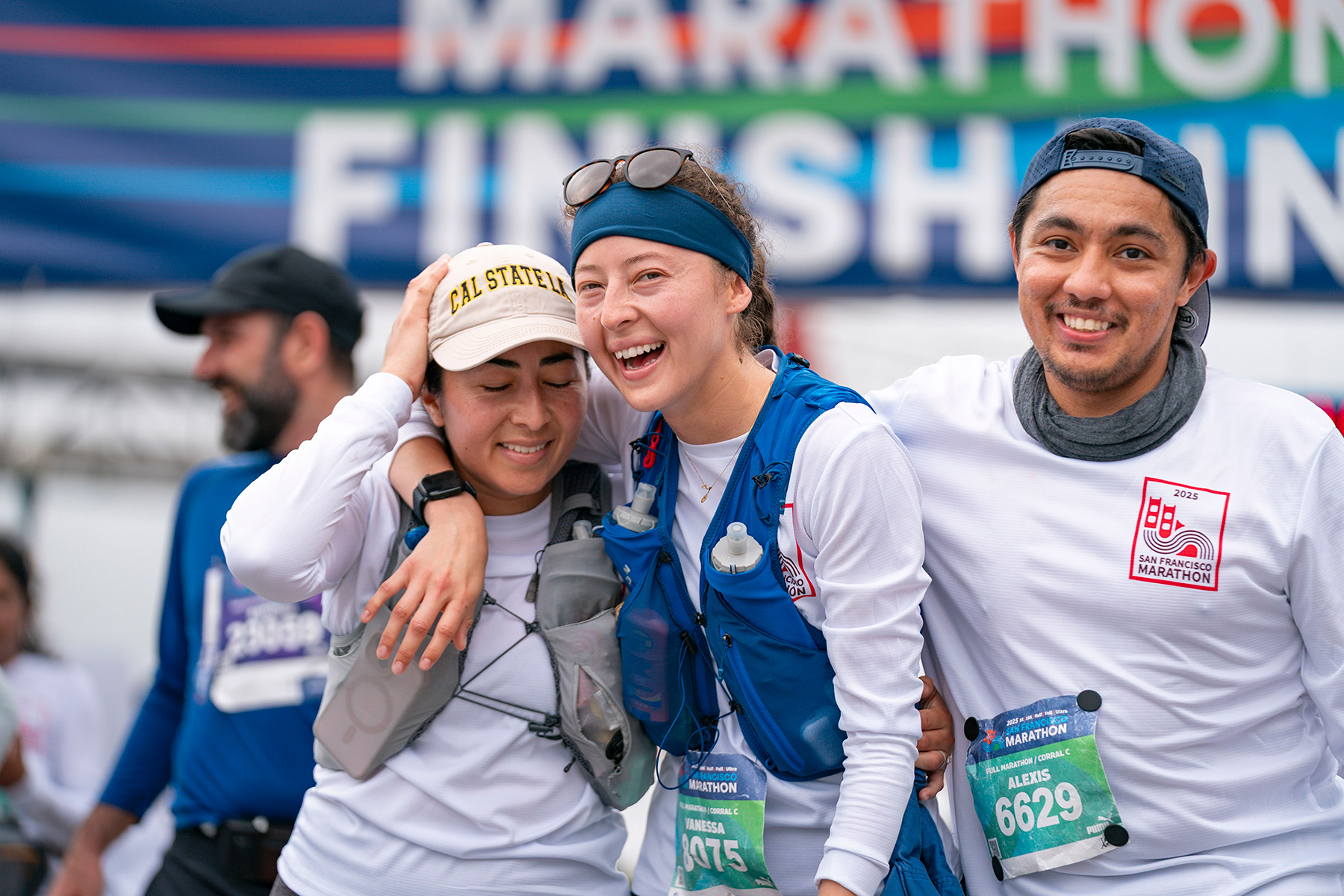So You’ve Done a Marathon. What’s Your Next Challenge?
Have you gotten over the “I’m never doing this again” phase? Are you starting to think about what’s next? You could, in theory, do ‘this’ again. Or you could take it a step further. You’ve done the marathon. Now, you may want to find your next challenge after the marathon—and there’s a world of possibilities waiting for you; transition to trails, run an ultramarathon, or do a triathlon. The world is your oyster.
Written & edited by Pavlína Marek
Of course, there are many more things you could do. When it comes to sports, there are endless possibilities. However, today, we’ll look at the top three options that runners who want to go beyond the marathon often go for.
Trail Running
If you’ve never heard about trail running, it’s the same thing you’ve been doing on the road or the track—you just do it on trails. It comes with its own challenges; however, the rewards are totally worth it.
Why Trail Running
Trail running is like road running’s more playful sibling. It’s fun and challenging at the same time, making your runs different every time. Trails tend to be gentler on your joints thanks to their softer surface, and the greenery you’ll be surrounded by while out on the trails is like a healing potion for your mind.
Pace isn’t of such importance on trails as it tends to be on roads. The majority of trail runners will be concerned more with whether you had fun than how fast you ran. Especially if you’re anxious about your speed, trails are the best environment to come back to the most crucial things in running: having fun. It’s okay to go fast and push past your boundaries. However, trail running will help you slow down and take time to appreciate the fact that you can run.

What to Expect
Unless the trail is a smooth, hard-packed dirt road, you’ll be slower. Don’t let that dissuade you from going full trail-mode—because of the varied terrain that often includes rocks, roots, and more hills than road running, you’ll become a stronger, more balanced runner. Your legs—and especially feet—will use muscles they haven’t used before, and you’ll gain more stability the longer you do trails.
Because of the variety in terrain, you may be more prone to tripping and falling at the beginning. Again, don’t be afraid to slow down. Especially on technical terrain, trail running is more like a dance with the environment. Focus on footwork and short, quick steps rather than long and fast strides. That way, you’ll have more opportunities to react to the surface and adjust your strides.
Ultramarathons
When the marathon distance becomes too short, there’s always the ultra. An ultramarathon is anything longer than a marathon. A “beginner” ultra is a 50K; a more advanced one would be a 50-miler. (We do have one of these!) It goes up from there, all the way to 3,100 miles around a single block in NYC.
Why Ultramarathons
Every time you do an ultra—even if you don’t finish—you will learn a lot about yourself, both about your body and your mind. You’ll find out that you’ve most likely been underestimating what you can do. It’ll help you gain confidence in areas of your life that are not at all related to running. As Dean Karnazes once said, “If you want to run, run a mile. If you want to change your life, run a marathon. If you want to talk to God, run an ultra.”
What to Expect
Most ultramarathons are run on trails, since their softer and varied surface tends to be more forgiving than tarmac. If you’re doing a road ultra, your body will likely take a beating, and you’ll need to pay more attention to how it responds to the tarmac. In my experience, running a 50K on trails is easier than running a marathon on the road, both physically and mentally.
Training for an ultra will most likely require a bit more of your time than training for a marathon did. You’ll likely focus more on “time on feet” rather than running a certain number of miles. Based on your approach, you might have only one distance-based run a week!
Here’s a fun warning: when it comes to your friends and family, most of them probably won’t know what an ultra is and will keep calling it a marathon. Better get used to it; even a 250-km ultra I’m about to do in a month is still a marathon in my family’s eyes! You simply have to accept the fact that ultras aren’t done for fame; your reasons need to go beyond that if you want to keep going and finish.
Triathlons
If you’ve trained for a marathon, and especially if you’ve experienced some kind of injury during your training, you’ve probably done biking and swimming during your recovery and cross-training sessions. Triathlons combine all of these in a single race.
Why Triathlons
If you get bored easily, a triathlon might be a much better choice for you than an ultramarathon. The activities you’ll do are much more diverse. Combining three sports into one will also make you a stronger athlete overall; it’s not cross-training, it’s cross-fitness.
Just like ultramarathons, triathlons will also teach you many skills that you’ll use in your life, from patience to perseverance. They’ll help you improve your mental fortitude, find a great community of people to share your experiences with and to learn from, and teach you how to plan better. After all, squeezing three disciplines into a single training plan can be a bit of a challenge!
What to Expect
If you choose a triathlon as your next challenge after the marathon, you’ll need to incorporate swimming and biking into your training as more than just cross-training or recovery sessions. Overall, you’ll have a much more balanced training schedule than when you train for a foot race.
Just like with ultras, you may choose to focus more on time-based training than on distance. As an extra challenge, you’ll need to do “brick workouts” when you stack two activities on top of each other to simulate race day; in that sense, training for a triathlon may be more challenging than trail running or ultras.
A little warning here: despite balancing your training out, triathlons tend to have a higher injury incidence than endurance running, both during training and on race day. According to Triathlete, “A recent study of ultra-endurance runners, cyclists, and triathletes found a self-reported overall injury prevalence of 50%, with the highest number of injuries per athlete reported by triathletes. A 2022 review study reported an overuse injury rate of 37-91% and an acute injury rate of 24-27% in triathletes.”

Conclusion
Whichever sport you choose to pursue when you decide to take on the next challenge after a marathon, it’ll help you grow and explore what you can do. Whether you choose to play in the woods on a trail run, push your boundaries during an ultramarathon, or become a more balanced athlete via triathlons, I hope your next challenge will be fun, fulfilling, and fantastic!


